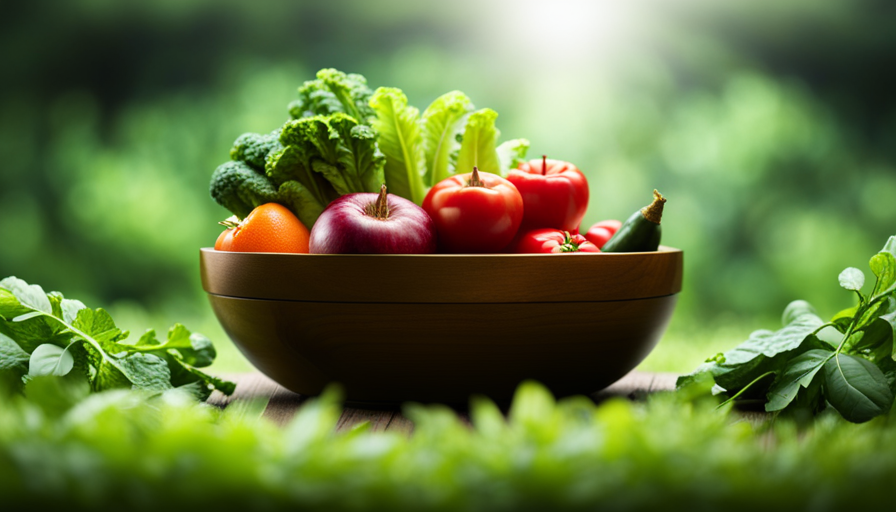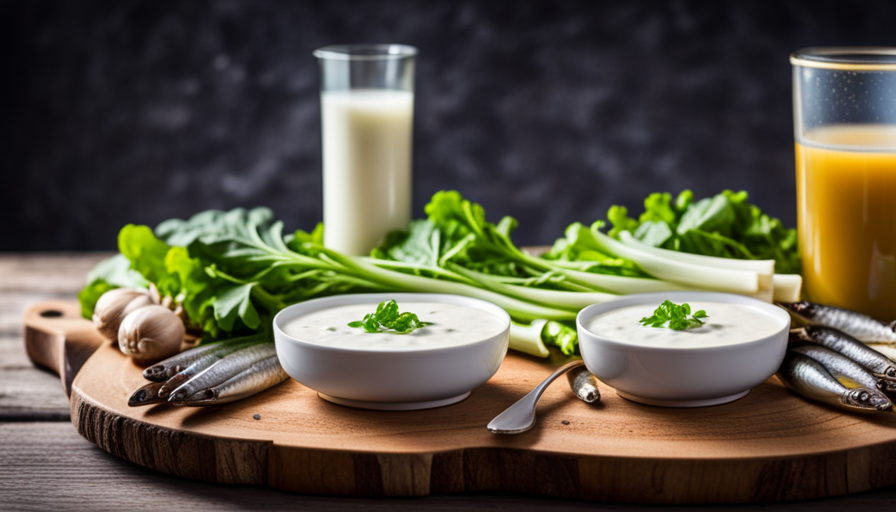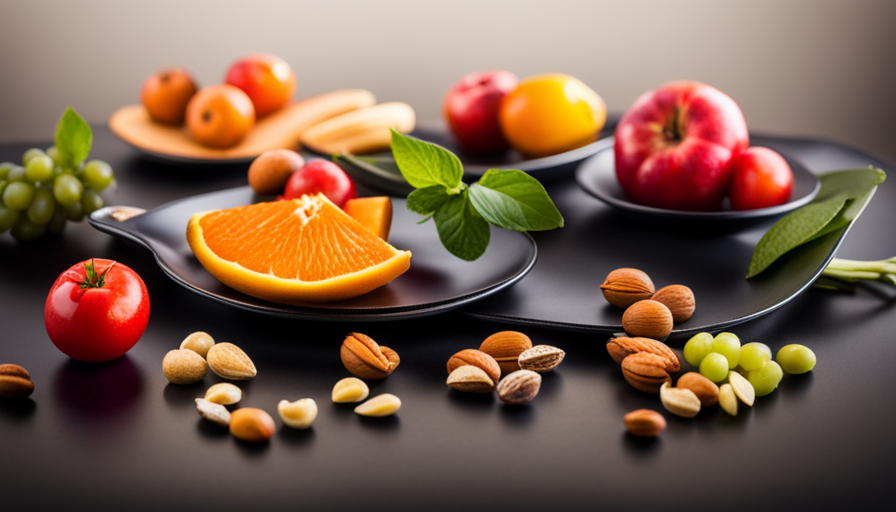Have you ever thought about the unseen hazards that are present in our daily lives? Radiation is a prime example of a danger that can significantly impact our well-being.
From the electronic devices we use to the nuclear power plants that generate our electricity, radiation is prevalent in our modern lives.
But fear not, for there are steps you can take to protect yourself and your loved ones.
Welcome to the raw food blog, where we delve into the world of radiation and provide practical tips on how to minimize your exposure.
In this article, we will explore the sources of radiation, its effects on the body, and most importantly, what you can do to safeguard your health.
So, if you’re ready to uncover the secrets of radiation protection, keep reading and prepare to be amazed.
Key Takeaways
- Radiation is a prevalent danger in modern life that can have serious effects on health.
- Limiting exposure to radiation is important, such as avoiding unnecessary medical procedures and using protective measures.
- Proper insulation and ventilation can minimize radiation exposure in the home.
- Consuming a diet rich in antioxidants and vitamins can help strengthen the body’s defense against radiation.
Understanding Radiation and its Sources
Understanding radiation and its sources is crucial for taking steps to protect yourself and your loved ones. Radiation is a form of energy that comes from various sources, both natural and man-made. It is important to be aware of these sources and understand how they can affect our health.
Radiation can be found in everyday life, and it is important to take radiation safety precautions to minimize exposure. One common source of radiation is the sun. While sunlight is essential for vitamin D synthesis, prolonged exposure to ultraviolet (UV) radiation can increase the risk of skin cancer. It is important to use sunscreen, wear protective clothing, and seek shade during peak sun hours to reduce the risk.
Another source of radiation is radon, a naturally occurring radioactive gas that can seep into homes through the ground. Radon exposure is the leading cause of lung cancer in non-smokers and can be reduced by testing your home for radon and implementing proper ventilation systems.
Additionally, medical procedures such as X-rays and CT scans can expose us to radiation. While these procedures are important for diagnosing and treating illnesses, it is crucial to discuss the risks and benefits with your healthcare provider and only undergo necessary scans.
By understanding radiation and its sources, we can make informed decisions to protect ourselves and our loved ones. Incorporating radiation safety precautions into our everyday lives can help minimize exposure and ensure a healthier future.
The Effects of Radiation on the Body
Contrary to popular belief, there are numerous theories surrounding the effects of radiation on the human body. When it comes to pregnancy, exposure to high levels of radiation can have detrimental effects on both the mother and the fetus. Studies have shown that radiation can increase the risk of birth defects, miscarriages, and developmental issues in newborns.
It is crucial for pregnant women to avoid unnecessary exposure to radiation and take extra precautions when undergoing medical procedures involving radiation.
Long-term effects of radiation exposure can also be a cause for concern. Prolonged exposure to high levels of radiation has been linked to an increased risk of developing certain types of cancer, such as leukemia and thyroid cancer. Additionally, radiation can damage the cells in our bodies, leading to tissue damage and organ dysfunction over time.
To protect yourself from the harmful effects of radiation, it is important to limit exposure whenever possible. This can be done by avoiding unnecessary medical procedures that involve radiation, using protective measures such as lead aprons during x-rays, and living in areas with low levels of background radiation. Regular check-ups with healthcare professionals can also help monitor any potential health issues related to radiation exposure.
Understanding the effects of radiation on the body is crucial for making informed decisions about our health. By taking necessary precautions and staying informed, we can minimize the risks associated with radiation exposure and ensure a healthier future for ourselves and our loved ones.
Minimizing Radiation Exposure in Your Home
To minimize your exposure to radiation in your home, it’s important to take simple steps like using a lead apron during x-rays and living in areas with low levels of background radiation. However, it’s not just when you’re at the doctor’s office or outside that you need to be cautious.
There are also ways to minimize radiation exposure in your own home. One important step is to ensure that your home is properly insulated. Insulation helps to block out external radiation sources, such as radon gas. Radon is a radioactive gas that can seep into homes through cracks in the foundation. By sealing these cracks and ensuring proper ventilation, you can significantly reduce your exposure to radon.
Another way to minimize radiation exposure is to limit the use of certain electronic devices. For example, keeping your cellphone a safe distance away from your body when not in use can reduce exposure to radiofrequency radiation. Additionally, using a hands-free device or speakerphone during calls can further minimize exposure.
When it comes to protecting children from radiation, it’s important to be especially vigilant. Ensure that their bedrooms are located away from sources of radiation, such as Wi-Fi routers and cordless phones. Additionally, limit their use of electronic devices and encourage outdoor play to reduce overall exposure.
By following these simple steps, you can minimize radiation exposure in your home and protect yourself and your loved ones from potential harm.
Radiation Protection Tips for Electronic Devices
Make sure ya keep those precious electronic devices at a safe distance from your body to shield yourself from any sneaky radiation. Electromagnetic radiation emitted by electronic devices can potentially harm our bodies if we’re exposed to it for long periods. To minimize your exposure, follow these tips:
-
Increase the distance: Keep your electronic devices, such as smartphones and tablets, at least an arm’s length away from your body. This helps reduce the amount of radiation absorbed.
-
Use speakerphone or headphones: When making calls, opt for speakerphone or use headphones with a built-in microphone. By keeping the device away from your head, you minimize exposure to radiation.
-
Limit use on your lap: Avoid placing laptops or tablets directly on your lap, as this can expose your reproductive organs to radiation. Instead, use a desk or table to create a safe distance.
-
Consider radiation shielding: Look for products that provide radiation shielding for your electronic devices. These can include cases, sleeves, or screen protectors that block or deflect electromagnetic radiation.
By implementing these tips, you can reduce your exposure to electromagnetic radiation emitted by electronic devices. Remember, it’s important to take proactive steps to protect yourself and maintain a healthy balance between technology and well-being.
The Role of Diet in Radiation Protection
Keep in mind that maintaining a balanced diet can play an essential role in shielding your body against harmful radiation. When it comes to radiation protection, the role of antioxidants in your diet is crucial.
Antioxidants are powerful compounds that help neutralize the harmful effects of radiation by combating free radicals in your body. Include foods rich in antioxidants such as berries, dark leafy greens, nuts, and seeds in your daily meals.
Additionally, hydration is of utmost importance in radiation protection. Drinking an adequate amount of water helps flush out toxins from your body and supports overall cellular health. Aim to drink at least 8 glasses of water a day to stay properly hydrated.
Incorporating foods that are high in vitamins A, C, and E can also strengthen your body’s defense against radiation. Foods like carrots, oranges, spinach, and almonds are excellent sources of these vitamins and should be included in your diet.
It is recommended to limit your intake of processed foods, as they are often low in nutrients and can weaken your body’s ability to protect against radiation. Opt for fresh, organic fruits and vegetables whenever possible.
By following a diet rich in antioxidants, staying hydrated, and consuming nutrient-dense foods, you can support your body’s natural defense mechanisms and minimize the harmful effects of radiation.
Natural Remedies for Detoxifying Radiation
Detoxifying radiation naturally is possible with these powerful remedies. When it comes to protecting yourself from radiation exposure, there are several natural remedies and detoxification techniques that can help.
One of the most effective natural remedies is consuming foods that are rich in antioxidants, such as berries, leafy greens, and cruciferous vegetables. These foods help to neutralize free radicals and reduce the oxidative stress caused by radiation.
Another powerful natural remedy is herbal teas, such as green tea and chamomile tea, which have been found to have radioprotective properties.
In addition to incorporating these natural remedies into your diet, there are also detoxification techniques that can help to remove radiation from your body.
One technique is dry brushing, which involves using a natural bristle brush to gently brush your skin in circular motions. This helps to stimulate the lymphatic system, which is responsible for removing toxins from the body.
Another technique is using clay baths, which involve soaking in a bath with bentonite clay. The clay helps to draw out toxins, including radiation, from the body.
Overall, by incorporating these natural remedies and detoxification techniques into your routine, you can help to detoxify radiation from your body and protect yourself from its harmful effects.
Creating a Safe Environment for Radiation Protection
Creating a safe environment for radiation protection is essential in safeguarding yourself from its harmful effects. Here are four key steps you can take to ensure your safety:
-
Choose safe foods: Consuming a diet rich in fresh, organic fruits and vegetables can help to support your body’s natural detoxification processes. Opt for foods that are known for their detoxifying properties, such as leafy greens, berries, and cruciferous vegetables. These foods are not only packed with essential nutrients but also help to eliminate toxins from your body.
-
Minimize exposure: Limit your exposure to radiation by avoiding unnecessary sources such as X-rays and excessive use of electronic devices. Whenever possible, opt for natural alternatives to artificial sources of radiation, such as sunlight instead of tanning beds.
-
Shield your home: Use materials that can act as barriers to radiation, such as lead or copper, when constructing or renovating your home. Additionally, consider investing in protective devices like radiation shields for your electronic devices to reduce your exposure.
-
Detoxify regularly: Incorporate natural detoxification methods into your routine, such as drinking plenty of water, engaging in regular exercise, and getting enough sleep. These practices help to support your body’s ability to eliminate toxins, including radiation, from your system.
By following these steps, you can create a safe environment that supports radiation protection and promotes overall well-being. Remember, taking proactive measures is crucial for minimizing the potential risks associated with radiation exposure.
Understanding the Risks of Nuclear Power Plants
Understanding the risks of nuclear power plants can help you make informed decisions about your energy sources and ensure the safety of your community. Nuclear plant accidents pose significant threats to public health and must be taken seriously.
One of the main concerns with nuclear power plants is the potential for accidents. While safety measures are in place, accidents can still occur due to human error, equipment failure, or natural disasters. These accidents can result in the release of radioactive materials into the environment, leading to serious health consequences for nearby communities.
Exposure to radiation from nuclear plant accidents can cause various health problems. Acute effects may include radiation sickness, burns, and even death. Long-term effects can include an increased risk of cancer, genetic mutations, and other chronic illnesses. It is crucial to understand these risks and take necessary precautions to protect yourself and your loved ones.
To mitigate the risks associated with nuclear power plants, it is essential to have proper safety protocols in place. This includes regular inspections and maintenance of equipment, emergency response plans, and ongoing monitoring of radiation levels. Additionally, investing in renewable energy sources can help reduce reliance on nuclear power and lessen the potential for accidents.
By understanding the risks of nuclear power plants and advocating for safe energy alternatives, you can play a role in protecting your community’s well-being. Stay informed, support sustainable energy initiatives, and prioritize the health and safety of your community.
The Importance of Regular Health Check-ups
Make sure you prioritize your health by scheduling regular check-ups with your doctor. Regular health check-ups are crucial for detecting any potential health issues early on and taking proactive steps to prevent them from worsening. By visiting your doctor regularly, you can stay on top of your overall well-being and address any concerns or symptoms that may arise.
In addition to regular check-ups, there are two essential factors that contribute to maintaining good health: regular exercise and stress management. Engaging in regular physical activity not only helps to maintain a healthy weight but also reduces the risk of chronic diseases such as heart disease, diabetes, and certain types of cancer. Aim for at least 150 minutes of moderate-intensity aerobic exercise or 75 minutes of vigorous-intensity exercise per week.
Stress management is equally important as it plays a significant role in our overall health. Chronic stress can lead to a variety of health problems, including high blood pressure, heart disease, anxiety, and depression. Practice stress management techniques such as deep breathing exercises, meditation, or engaging in activities that you enjoy to help alleviate stress and promote relaxation.
By incorporating regular exercise and stress management into your routine and scheduling regular check-ups with your doctor, you are taking proactive steps towards maintaining good health and well-being. Remember, prevention is key, and investing in your health now will pay off in the long run.
Taking Action: Advocating for Radiation Safety Measures
Let’s kick it into gear and take action by advocating for radiation safety measures. When it comes to protecting ourselves from the potential dangers of radiation, it’s crucial to be proactive and push for stricter regulations and guidelines. By advocating for radiation safety measures, we can help ensure that our communities are protected and that the risks associated with radiation exposure are minimized.
One of the most effective ways to advocate for radiation safety is by raising awareness about the issue. Educate yourself and others about the potential risks of radiation exposure, and share this information with your friends, family, and community. By spreading the word, you can help generate support for stricter regulations and encourage others to take action.
Additionally, it’s important to get involved in advocacy groups and organizations that are dedicated to radiation safety. These groups often have resources and strategies in place to push for government regulations and policies that prioritize public health. By joining these groups, you can amplify your voice and work collectively towards a safer environment.
Lastly, don’t be afraid to reach out to your local representatives and government officials. Write letters, make phone calls, and attend public meetings to express your concerns and advocate for stronger radiation safety measures. Government regulations play a crucial role in protecting the public, and by actively engaging with these decision-makers, you can have a direct impact on the policies that are put in place.
Advocating for radiation safety measures is an essential step in protecting ourselves and our communities. By raising awareness, getting involved in advocacy groups, and engaging with government officials, we can work towards a safer and healthier environment for everyone. Let’s take action and make a difference.
Frequently Asked Questions
What are the different types of radiation sources?
Radiation comes from various sources, including radiation therapy and nuclear power. Radiation therapy uses high-energy particles to target and destroy cancer cells. It is a common treatment for cancer patients.
On the other hand, nuclear power generates electricity by using controlled nuclear reactions, which produce radiation. While both sources have their benefits, it’s important to understand and manage the potential risks associated with radiation exposure.
Are there any natural ways to protect against radiation?
To protect against radiation, there are natural remedies you can try. One option is to consume foods that are rich in antioxidants, like berries, leafy greens, and turmeric. These help to reduce the oxidative stress caused by radiation.
Another option is to incorporate herbs like spirulina and chlorella into your diet, as they can help to detoxify the body and support immune function.
Remember, these remedies aren’t a substitute for professional advice, but they can be a practical addition to your radiation protection plan.
How does radiation exposure affect children differently than adults?
Radiation exposure can have different effects on children compared to adults. Children’s rapidly developing bodies are more sensitive to radiation, putting them at higher risk for long-term consequences. The effects of radiation on child development can include growth problems, intellectual disabilities, and an increased risk of developing cancer later in life.
It is essential to minimize children’s exposure to radiation by avoiding unnecessary medical tests and ensuring their environment is free from sources of radiation, such as radon gas.
What are some common symptoms of radiation poisoning?
Common symptoms of radiation poisoning include nausea, vomiting, diarrhea, and fatigue. You may also experience hair loss, skin burns, and a weakened immune system. It’s important to seek medical help immediately if you suspect radiation exposure.
Common treatments for radiation poisoning include medication to manage symptoms and techniques like chelation therapy to remove radioactive materials from the body. However, it’s crucial to note that radiation poisoning can have long-term effects, such as an increased risk of cancer and other health complications.
How can I test the radiation levels in my home?
To test radiation levels in your home, there are a few methods you can use. One option is to purchase a radiation detector, which can measure the levels accurately.
Another method is using a Geiger-Muller counter, which detects radiation through a gas-filled tube.
Once you have the results, it’s important to interpret them correctly. If the levels are higher than normal, consider seeking professional advice or taking measures to reduce your exposure.
Stay informed and keep yourself and your loved ones safe.
Can a Raw Food Diet Help Protect Against Radiation?
Switching to a raw vegan diet can potentially aid in protecting the body against radiation. Consuming a variety of nutrient-dense raw vegan recipes success can provide the necessary antioxidants and phytonutrients that support the body’s natural defense mechanisms against radiation damage.
Conclusion
So there you have it, folks! After diving into the world of radiation and its potential dangers, it’s clear that we can’t take this issue lightly.
But fear not, for with a little knowledge and a dash of common sense, you can protect yourself and your loved ones from the harmful effects of radiation.
From minimizing exposure in your home to advocating for safety measures, there are steps you can take to create a safer environment.
Remember, knowledge is power, and in this case, it’s also your shield against radiation’s invisible threat.
Stay informed, stay safe, and keep those health check-ups on your calendar!










